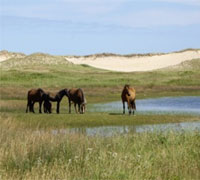 |
| Feral horses have inhabited Canada’s Sable Island for hundreds of years. Photo: Wikipedia |
The government of Canada has granted National Park Reserve
status to Sable Island, a narrow, sandy island approximately 180 miles off the
coast of Nova Scotia.
equines known as Sable Island Horses or Sable Island Ponies. The current herds
are descendants of horses brought to graze on the island beginning in the
1700s. Around 1760, Boston merchant Thomas Hancock shipped a herd of 60 horses
to the island. Hancock had been hired to transport Acadians from Nova Scotia to
the American colonies after they were deported by the British authorities. The
horses Hancock moved to Sable Island were most likely horses that he had taken
when the deported Acadians were forced to abandon their homes, belongings and
livestock.
Today, the Sable Island Horses have evolved into a stocky, hardy breed able to withstand the sometimes inhospitable conditions on the island. Most are bay or other dark colors, although palominos and pintos are said to exist within the herds.
Horses on Sable Island have been protected from
removal or interference by Canadian law since 1961. In 2008, Nova Scotia
declared the Sable Island Horse as the official provincial horse. The new
National Park status for the island will protect the horses’ habitat from
encroaching oil drilling that takes place in the ocean nearby. It will also
open the island to more opportunities for tourism, although the island’s remote
location and limited resources may deter visitors.
Besides the feral horses, Sable Island is also home
to a bird sanctuary and a population of grey seals.






Sounds wonderful. Wish I could go there.
This is wonderful news. Glad a country recognizes it’s heritage and doesn’t try to eliminate it.
As long the wild horses are safe. :]
I think that protecting the horses is wonderful, but since there is interference – photographers making money off them, this national park should make sure that the horses are attended to in times of need. I have seen a documentary years ago where horses with a broken limb were left to die on their own. This is unacceptable in my view. If we are supposing to protect them, and we allow others to make money off them, we need to be truly taking care of them – doing health checks, fixing what can be fixed. That is true protection. Watching an injured animal die on its own when you can do something is cruel. Let’s do more.